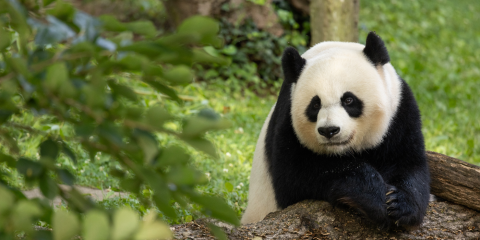Physical Description
Pale-headed saki monkeys, or white-faced saki monkeys, are named for the male's appearance. Males are black except for the head, which is white or reddish, while females are mostly brown to brown-gray, with paler bellies, and have bright white to pale red stripes extending from each eye to the corners of the mouth.
Size
Their bodies are about 12 to 16 inches (30 to 42 centimeters) long, plus a tail of the same length. They weigh about four to five pounds (about 2 kilograms). Their tails are not prehensile.
Native Habitat
Pale-headed sakis are found in Northern South America in Brazil, French Guiana, Guyana, Suriname and Venezuela.
They live in secondary, ridge, savanna and marsh forests, usually at elevations of 688 to 2,460 feet (210 to 750 meters). They move through the forest both quadrupedally and by leaping. They are wholly arboreal, but sometimes descend to the lower limbs of trees or even to bushes in search of food.
Lifespan
The average life span for this monkey is 15 years, but in human care they may reach 35 years.
Communication
Duet vocalizations between males and females are important in maintaining territorial boundaries, as well as the social bond between pairs. They may also raise their hair and jump up and down on branches while emitting a loud, shrill, territorial call.
Food/Eating Habits
Pale-headed sakis eat mainly fruit, and they have robust incisors and canines to break through the tough skins and shells. They also eat seeds, nuts, leaves and insects, especially ants. They are an important seed disperser for many plants.
They will sometimes eat soil and minerals, most likely to supplement their diet with important minerals.
At the Smithsonian's National Zoo, they are fed canned marmoset diet, bananas, grapes, apples, string beans, fruit and mealworms.
Sleep Habits
They are diurnal. When resting, this species most often clings vertically to a tree trunk and will commonly leap from this position as well.
Social Structure
Sakis live in monogamous pairs or small family groups of two to five animals. Juveniles may stay with their parents for up to a year or two after the birth of the next infant. These small groups may come together to form larger congregations.
Reproduction and Development
The breeding season in the wild is not clearly known. Births in human care occur throughout the year. The estrous cycle lasts 18 days, and gestation is five months, after which a single baby is born. Mothers carry infants on their hip for the first month and then the baby rides on her back.
Conservation Efforts
Sakis are hunted for food and captured for pets, but do not appear to be endangered in Brazil. Habitat destruction also threatens this species.
Help this Species
- Reduce, reuse and recycle — in that order! Cut back on single-use goods, and find creative ways to reuse products at the end of their life cycle. Choose recycling over trash when possible.
- Be a smart consumer. Choose products made with sustainable ingredients, such as Smithsonian certified Bird Friendly coffees, which support farmers striving to limit their impact on wildlife and habitat.
- Practice ecotourism by being an advocate for the environment when you’re on vacation. During your travels, support, visit or volunteer with organizations that protect wildlife. Shop smart too! Avoid buying products made from animals, which could support poaching and the illegal wildlife trade.
- Choose your pets wisely, and do your research before bringing an animal home. Exotic animals don’t always make great pets. Many require special care and live for a long time. Tropical reptiles and small mammals are often traded internationally and may be victims of the illegal pet trade. Never release animals that have been kept as pets into the wild.
Animal News

QUIZ: Can You Identify the Wildlife in Asia’s Mountain Forests?
